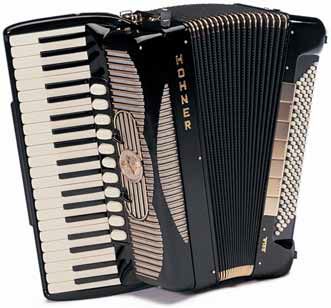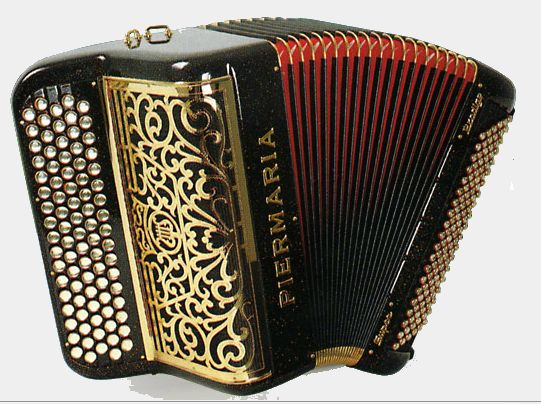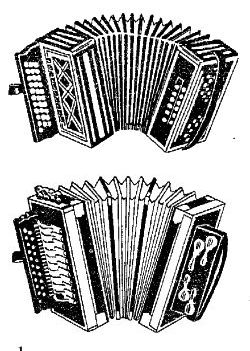Types of Accordions
Various types of accordions include Piano Accordion with piano keys, European Chromatic Accordion (having stair-step rows of buttons or keys), Melodeon (Diatonic Button Accordion), and Bayan (Russian Chromatic Accordion).
Accordion Types Described
 |
Piano Accordions |
The piano accordion would be the most common type seen throughout many countries of the world, including the U.S.A. It has a piano keyboard on one side meant to be played with the right hand, attached to the "treble" casing with the sets of the treble reeds installed in it, and a bellows to supply air, and a casing on the left, containing the "bass" sets of reeds, having button keys which usually play chords and bass notes (see below). The most common bass note arrangement is the "Stradella" where the basses are in a circle of fifths, e.g., C bass note marked with an indentation or Rhinestone, and G D A E B F# going towards the direction of the player's head and from C F Bb etc. towards the foot. Usually those tonic bass notes will be in the second row outwards from the bellows, with the major third next to the bellows. Then the third row from the bellows will be the Major chord, then the Minor chord, then the dominant seventh, resolving into the subdominant, like C E G Bb with often the fifth (G) removed resolving to the F major or Minor, and the last outer row the Diminished chord with usually only 3 notes, e.g., A C Eb. This is often a grid of 6 X 20 buttons, 120 bass. 12 basses, 48 basses or 60 bases, etc. would be a subset of 120 basses with the C row somewhere in the middle. If the 120 bass has an extra row it would be either next to the bellows, minor third basses, or an extra outer row augmented dominant chords , like C E G# (rare) and there are even rarer, 160 basses.
The treble keyboard that goes with the 120 bass accordion is usually 41 keys ranging from F to A including 24 white and 17 black keys, which might actually be whatever color the manufacturers felt would be attractive. The standardized full-size 41 key keyboard measure 19-1/4 inches from thje outer edge of the F key to the outer edge of the A key. Smaller 41 key 120 bass accordions were made to weigh less and many of those quite small were made for children during the U.S. "accordion school" boom period of the 1960's and 1970's.
 |
Chromatic Accordions |
Aside from the rare "Checkerboard" chromatic accordion described below, most chromatic accordions divide the twelve-tone chromatic scale into three rows of buttons or keys. The C row is C, D#, F#, A etc. repeated at intervals of an augmented second; the B row is D, F, G#, B etc. and the G row is E, G, A#, C#, etc. There are two possible arrangements of these rows of keys, called the C system and the B system. With the "C row" on the outer edge of the keyboard, then the "B row", and then the "G Row" it is called the "C System" or "C-Griff". The "B System" or "B-Griff" has the B row on the outer edge and then the C row and the G row. The rows of either system are usually repeated forming 4 to 6 rows, so the player can play an any key (transposing) using the exact same "fingering" pattern, which of course would be impossible in the irregular pattern of five black and seven white keys of the piano-style keyboard. NOTE: Some older style Chromatic accordions have rows of square keys arranged in a "stair-step" pattern instead of having round buttons.
 |
Diatonic Accordions, |
Diatonic accordions have button keyboards and the newer ones often have a rounded streamlined look. They can have from one to several rows of button keys. Each row of keys will play a diatonic scale for instance, C, D, E, F, G, A, B, C etc. and usually a note of the major chord, e.g., C, E, G will sound on one of the keys when the bellows are pressed, and another note of the seven-tone major scale, e.g., D, F, A, B will sound when the bellows are expanded or pulled. Each row would be in a different key, so the outer row might be in G and the next row might be in C, and if there are 3 rows, the third row might be in F. The rows on the standard diatonic accordion are a fifth interval apart, so a 3-row diatonic could have the rows in G C F or F Bb Eb, etc.
The so-called "Irish" button accordion has the outer row key one-half tone separated from the next row. Nowadays B/C is common or C#/D. So that the outer row might have the C# major scale and the adjacent row might have the D major scale. But on older accordions, it could be D/C# instead of C#/D for example. And F#/F is possible; in fact anything is possible.
Speaking of anything being possible, the keys on a row could play the same note both ways, and it could have the scale divided between 2 rows with the rows being a major fourth apart, and other regional variations found mainly in Russia.
Free Reeds.
"The accordion is a portable musical instrument operated with bellows and keys." New Standard Accordion Method 1939 by Margaret Synnberg.
An accordion is called a "free reed instrument". The sounds of an accordion, or other free reed instruments are made by vibrating tongues called "reeds". Each reed is riveted onto a "reed plate", and the tip of the reed is pulled into its slot in the reed plate by air flow, setting up a vibration. The reeds are commonly made of steel, and the better the quality of the steel and the more precisely the reed fits into the slot, the better the reed quality. The best reeds are made by hand, an art that is less commonly practiced than it once was. Inexpensive accordions, often made in China and sold as a commodity, usually have inferior steel for the reeds and are difficult to keep in tune. In years gone by free reeds sometimes were made of brass, and for mouth organs and melodicas they still are.
A high quality steel reed when properly set in the reed plate, will begin to sound with very little air pressure change, and it will have a wide dynamic range from loud to soft, whereas a cheaply made "commodity" reed will not respond well to air pressure, easily going flat with increased air flow. Even a high quality reed needs to be clean and firmly set on its chamber in the reed carrier or "block", to sound well.
The "free" part of the name means that the reed is not touching the mouth of the musician, unlike for instance, a clarinet reed is. Free reed instruments include Concertinas, Mouth-organs, aka "Harmonicas", Bandoneons, Melodeons, Reed Organs, Melodica (a Hohner brand-name), Harmoniums and Accordions. Except for the Melodica and the Mouth-Organ operated by "lung power", most free reed instruments have a bellows which supplies air to the reeds. Reed organs sit on the floor, have the bellows inside, or can have an electric blower. But most free reed instruments have the bellows in the middle, with sets of reeds in two casings on either side, and the player works one or both casings from side to side to supply the air. The Harmonium is a Reed Organ, often used in India, that sits stationary usually on a table or stand, having no bass side casing with reeds inside, but the bellows is on the outside , and moved by the player to supply air, and there are drones, single notes which can be left on or off, playing a single note or a fifth interval like a set of bagpipes can do.
Definition of an Accordion
An accordion is of course, a member of the "free reed" family. It can be distinguished from the other free reed members, by the fact that a single button or key can play several tones simultaneously, forming a "chord" (see exception below). Along with the chords on the left or accompaniment side there one tow or 3 rows of keys (buttons) nearest to the left side of the bellows which play single low notes which together with the chords form the "Um-Pa-Pa" sound of the accompaniment. The bass casing is moved back-and-forth by the player to expand and contract the pleated bellows to the air to all of the reeds.
Note that there is one type of accordion i.e., "free bass" that has single notes per key only, but it was created as a variation of an accordion, so it is defined as "accordion" based on its ancestor. So it will look externally just like an accordion, which it is. In short, someone designed a modified accordion to not play chords with a single key, so that a player could play contrapuntal music with single notes in both hands. There are also "converter" accordions where a lever can be pressed to change the accompaniment side of the instrument from single notes to chords. So in distinguishing the "free bass" single note accordion from its cousins the concertina and bandoneon, you need to have seen an accordion before.
© Gaines Milligan 2012